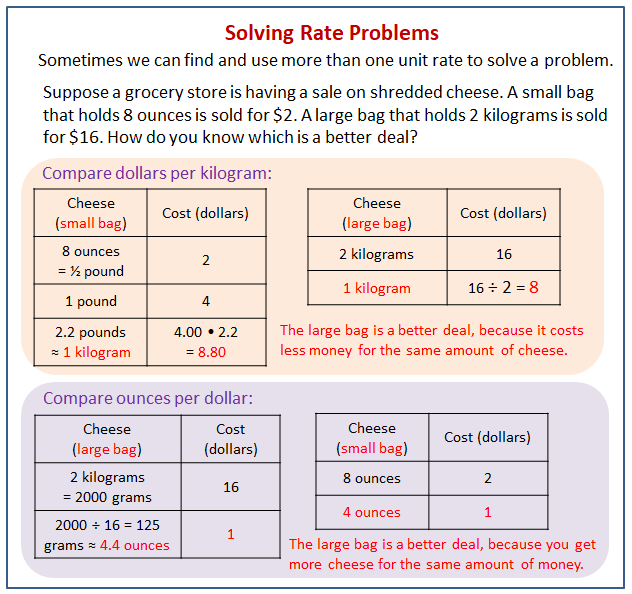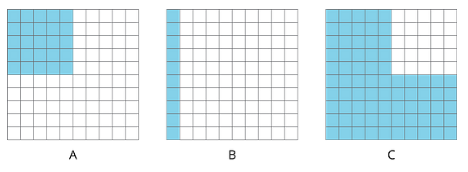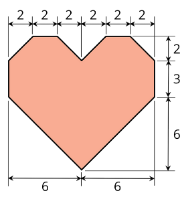Illustrative Mathematics Unit 6.3, Lesson 9: Solving Rate Problems
Learning Targets:
- I can choose how to use unit rates to solve problems.
Related Pages
Illustrative Math
Grade 6
Lesson 9: Solving Rate Problems
Let’s use unit rates like a pro.
Illustrative Math Unit 6.3, Lesson 9 (printable worksheets)
Lesson 9 Summary
The following diagram shows how to use more than one unit rate to solve a problem.

Lesson 9.1 Grid of 100
How much is shaded in each one?
Lesson 9.2 Card Sort: Is it a Deal?
Your teacher will give you a set of cards showing different offers.
- Find card A and work with your partner to decide whether the offer on card A is a good deal. Explain or show your reasoning.
- Next, split cards B–E so you and your partner each have two.
a. Decide individually if your two cards are good deals. Explain your reasoning.
b. For each of your cards, explain to your partner if you think it is a good deal and why. Listen to your partner’s explanations for their cards. If you disagree, explain your thinking.
c. Revise any decisions about your cards based on the feedback from your partner. - When you and your partner are in agreement about cards B–E, place all the cards you think are a good deal in one stack and all the cards you think are a bad deal in another stack. Be prepared to explain your reasoning.
Are you ready for more?
Time to make your own deal! Read the information on card F and then decide what you would charge if you were the clerk. When your teacher signals, trade cards with another group and decide whether or not you would take the other group’s offer.
Keep in mind that you may offer a fair deal or an unfair deal, but the goal is to set a price close enough to the value it should be so that the group cannot immediately tell if the deal you offer is a good one.
Lesson 9.3 - The Fastest of All
Wild animals from around the world wanted to hold an athletic competition, but no one would let them on an airplane. They decided to just measure how far each animal could sprint in one minute and send the results to you to decide the winner.
You look up the following information about converting units of length:
1 inch = 2.54 centimeters
| animal | sprint distance |
| cougar | 1,408 yards |
| antelope | 1 mile |
| hare | 49,632 inches |
| kangaroo | 1,073 meters |
| ostrich | 1.15 kilometers |
| coyote | 3,773 feet |
Lesson 9 Practice Problems
- A package of 11 slices of cheese costs $2.97.
How much would a package with 18 slices cost at the same price per slice? Explain or show your reasoning. - A copy machine can print 480 copies every 4 minutes. For each question, explain or show your reasoning.
a. How many copies can it print in 10 minutes?
b. A teacher printed 720 copies. How long did it take to print? - Order these objects from heaviest to lightest. (Note: 1 pound = 16 ounces, 1 kilogram ≈ 2.2 pounds, and 1 ton = 2,000 pounds)
| item | weight |
| school bus | 9 tons |
| horse | 1,100 pounds |
| elephant | 49,632 inches |
| kangaroo | 5,500 kilograms |
| grand piano | 15,840 ounces |
Which jobs paid better than others? Explain your reasoning.
5. Calculate and express your answer in decimal form.
a. ½ · 17
b. ¾ · 20
a. (0.2) · 40
a. (0.25) · 60
6. a. Decompose this polygon so that its area can be calculated. All measurements are in centimeters.
b. Calculate its area. Organize your work so that it can be followed by others.
The Open Up Resources math curriculum is free to download from the Open Up Resources website and is also available from Illustrative Mathematics.
Try the free Mathway calculator and
problem solver below to practice various math topics. Try the given examples, or type in your own
problem and check your answer with the step-by-step explanations.

We welcome your feedback, comments and questions about this site or page. Please submit your feedback or enquiries via our Feedback page.

